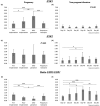Luteal expression of factors involved in the metabolism and sensitivity to oestrogens in the dog during pregnancy and in non-pregnant cycle
- PMID: 34704613
- PMCID: PMC9298758
- DOI: 10.1111/rda.14032
Luteal expression of factors involved in the metabolism and sensitivity to oestrogens in the dog during pregnancy and in non-pregnant cycle
Abstract
The canine corpus luteum (CL) is the main source of reproductive steroids during dioestrus in the dog and remains active even in the absence of pregnancy (non-pregnant dioestrus, physiological pseudopregnancy). Whereas the biological effects of 17β-oestradiol (E2) in the canine CL remain unclear, the transcriptional availability of oestrogen receptors, ESR1 and ESR2, as well as other modulators of local availability of E2, for example, HSD17B7 (converts oestrone into oestradiol), SULT1E1 (inactivates E2 binding capacity to its own receptors through sulphonation) and STS (reverts E2 sulphonation), were previously detected in the CL of non-pregnant bitches. The aim of the present work was to evaluate the mRNA amounts of these factors involved in luteal sensitivity and metabolism of E2 in the canine CL during the course of non-pregnant dioestrus (days 10, 20, 30, 40, 50 and 60 post-ovulation, n = 5/group) and at different stages of pregnancy (n = 4-6/group): pre-implantation (days 8-12), post-implantation (days 18-25), mid-gestation (days 35-40) and prepartum luteolysis. During pregnancy, the availability of ESR1, HSD17B7, SULT1E1 and STS decreased from mid-pregnancy to prepartum luteolysis. The main findings during non-pregnant dioestrus were as follows: increased ESR2:ESR1 ratio on days 40 and 50 after ovulation, decreasing during luteal regression (day 60); increased STS at day 30 when SULT1E1 levels decreased; increased availability of SULT1E1 transcripts during luteal regression; and decreased amounts of HSD17B7 mRNA in early dioestrus, increasing towards later stages. These results suggest that E2 signalling and biologically active local concentrations could diverge in response to time and pregnancy status of the bitch.
Keywords: Corpus luteum; 17β-oestradiol; dog (Canis lupus familiaris); non-pregnant dioestrus; pregnancy.
© 2021 The Authors. Reproduction in Domestic Animals published by Wiley-VCH GmbH.
Conflict of interest statement
The authors declare that they have no conflicts of interest.
Figures


References
-
- Concannon, P. W. , McCann, J. P. , & Temple, M. (1989). Biology and endocrinology of ovulation, pregnancy and parturition in the dog. Journal of Reproduction and Fertility. Supplement, 39(0449–3087), 3–25. - PubMed
-
- Feldman, E. C. , & Nelson, R. W. (2004). Ovarian cycle and vaginal cytology. In Feldman E. C., & Nelson R. W. (Eds.), Canine and feline endocrinology and reproduction (3rd ed.). Saunders.
MeSH terms
Substances
Associated data
- Actions
- Actions
- Actions
- Actions
- Actions
Grants and funding
LinkOut - more resources
Full Text Sources
Research Materials
Miscellaneous

